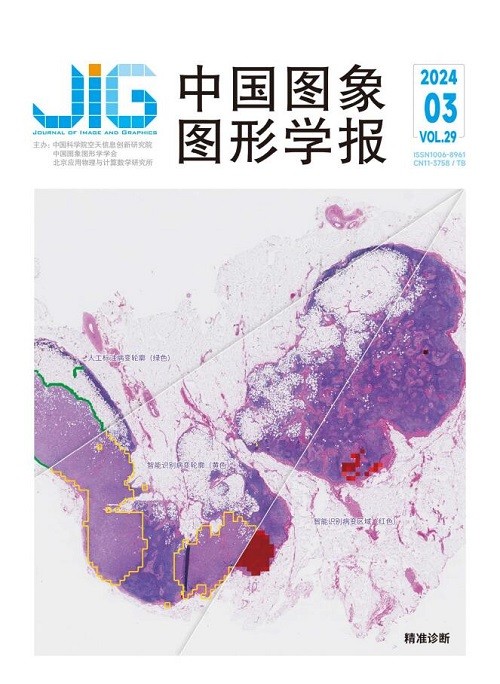
JIR-Net:用于光声层析图像重建的联合迭代重建网络
摘 要
目的 高质量的图像重建是光声层析成像(photoacoustic tomography,PAT)技术的关键,有限角度稀疏测量和组织非均匀的声学特性都会影响重建图像质量。采用迭代重建技术可在一定程度上提高图像质量,但是其结果依赖于有关成像目标的先验假设模型。而且在迭代优化过程中需要反复计算前向成像算子及其伴随算子,因此计算成本较高,需要合理选择正则化方法及其参数。为了解决该问题,提出一种根据不完备光声测量信号联合重建光吸收能量分布图和声速分布图的深度学习方法。方法 设计并搭建基于学习迭代策略的联合迭代重建网络(joint iterative reconstruction network,JIR-Net),网络由4个结构单元组成,每个单元包括特征提取、特征融合和重建3个模块。网络的输入是探测器在成像平面中采集的不完备光声信号和预设的常数声速,输出是重建的光吸收能量分布图和声速分布图。分别构建仿真、仿体和在体数据集,用于训练、验证和测试网络。在训练网络的过程中,将光吸收能量密度和声速的梯度下降信息整合到网络训练中,并利用反向传播梯度下降法求解非线性最小二乘问题。结果 数值仿真、仿体和在体实验结果表明:与交替优化法、U-Net后处理法和深度梯度下降法相比,JIR-Net重建的光吸收能量分布图的结构相似度可分别提高约39.5%、26.4%和7.6%,峰值信噪比可分别提高约95.6%、71.4%和15.5%。与交替优化法相比,JIR-Net重建的声速分布图的结构相似度和峰值信噪比可分别提高约34.4%和22.6%。结论 JIR-Net解决了由于有限角度稀疏测量和组织声速分布不均匀所致的光声图像质量下降问题,实现了从光声信号到高质量光吸收能量分布图和声速分布图的映射。
关键词
JIR-Net:a joint iterative reconstruction network forphotoacoustic tomography image reconstruction
Hou Yingsa1, Sun Zheng1,2, Sun Meichen1(1.Department of Electronic and Communication Engineering, North China Electric Power University, Baoding 071003, China;2.Hebei Key Laboratory of Power Internet of Things Technology, North China Electric Power University, Baoding 071003, China) Abstract
Objective Photoacoustic tomography(PAT) is a hybrid functional imaging modality developed rapidly in recent years. PAT is physically based on the photoacoustic effect, where biological tissues are irradiated by short laser pulses, inducing broadband(~MHz) ultrasonic waves(i. e., photoacoustic waves) due to optical absorption and thermoelastic expansion. Ultrasonic transducers deployed around the imaging target collect photoacoustic waves from which images are reconstructed to show the morphological structure and functional properties of tissues. High-quality image reconstruction is essential for PAT, which suffers from incomplete measurements and heterogeneous acoustic properties of tissues. Traditional image reconstruction methods include back projection, time reversal, Fourier transform-based reconstruction, and delay and sum. For simplicity, these methods are usually based on ideal assumptions about the imaging scenario, such as fixed speed of sound, a lossless acoustic media without attenuation, a point-like ultrasonic detector with sufficient bandwidth, and complete measurement. However, in real-world applications, these ideal scenarios often do not occur, leading to the degradation of the quality of images reconstructed using these methods. The model-based iterative reconstruction scheme is commonly used to improve image quality, where the inversion of a forward imaging model describing the generation of photoacoustic signal is iteratively solved. However, its real-time applications are limited by its high computational cost because the forward imaging operator and its adjoint operator need to be calculated repeatedly in the iterative process. Regularization tools with properly defined parameters are necessary to obtain stable optimization. In addition, the reconstruction quality highly depends on the prior assumptions of the imaging object. In recent years, deep learning has shown great potential in reconstructing high-quality images from photoacoustic measurements. This work aims to solve the problem of image quality degradation caused by incomplete measurement and heterogeneously distributed speed of sound. Method A deep learning method is proposed to reconstruct jointly images representing the distributions of optical absorption and speed of sound within the imaging domain from incomplete photoacoustic measurements. A convolutional neural network, named joint iterative reconstruction network(JIR-Net), is constructed based on an iterative learning strategy. Incomplete photoacoustic measurements are fed into the network, and images representing absorbed optical energy density and speed of sound distributions are output. The network consists of four structural units, and each unit is composed of three modules:feature extraction, feature fusion, and reconstruction. The feature extraction module extracts features from four inputs via convolution. The feature fusion module combines the features extracted from the input. Finally, the reconstruction module recreates the distributions of absorbed optical energy density and speed of sound. The network is trained using simulation, phantom, and in vivo datasets, where the gradient descent information of the absorbed optical energy density and the speed of sound distributions is incorporated into the network training. The nonlinear least square problem is solved by using the back propagation gradient descent. The validity of the method is demonstrated by simulation, phantom, and in vivo studies. Compared with traditional nonlearning methods, non-iterative learning method, and learning iterative method based on depth gradient descent, JIR-Net is superior in reconstructing high-quality images from sparse data measured in acoustically heterogeneous media. Result Numerical simulation, phantom, and in vivo experiment results show the trained JIR-Net is robust to data sparsity and insensitive to the initial iterative plan. Moreover, the superiority of JIR-Net in complex structure reconstruction is proven in vivo. Compared with the depth gradient descent method, the U-Net post-processing method, and the alternate optimization method, the structural similarity of the reconstructed images representing absorbed optical energy density distribution can be improved by 7. 6%, 26. 4%, and 39. 5%, respectively, and the peak signal-to-noise ratio can be improved by 15. 5%, 71. 4%, and 95. 6%, respectively. Compared with the alternate optimization method, the structural similarity and peak signal-to-noise ratio of the JIR-Net reconstructed speed of sound images are increased by 34. 4% and 22. 6%, respectively. Conclusion JIR-Net achieves the mapping from incomplete photoacoustic measurements to high-quality images representing the distributions of absorbed optical energy density and speed of sound. The method can be used for image reconstruction from limited-view sparse photoacoustic signals collected with any measuring geometry in acoustic media with inhomogeneously distributed speed of sound. The method eliminates the need for prior knowledge of the characteristics of the imaging target and reduces the need for scanning and detection equipment, enabling constructing more compact imaging systems.
Keywords
image reconstruction techniques photoacoustic tomography(PAT) deep learning absorbed optical energy density speed of sound (SoS) joint reconstruction gradient descent
|



 中国图象图形学报 │ 京ICP备05080539号-4 │ 本系统由
中国图象图形学报 │ 京ICP备05080539号-4 │ 本系统由